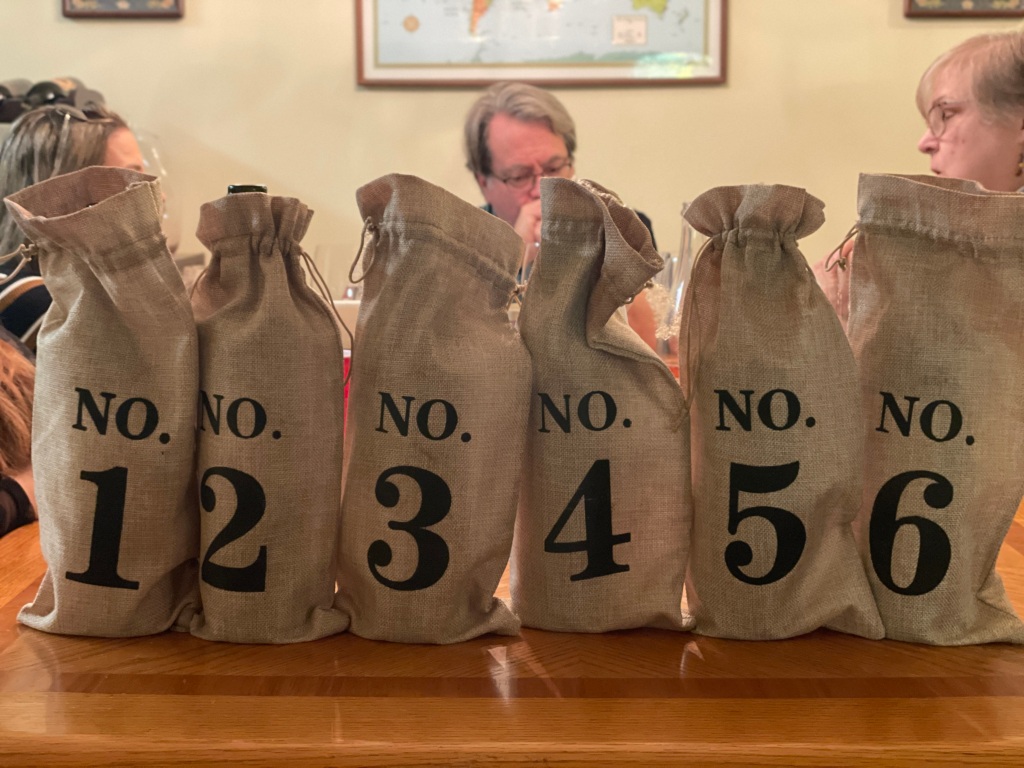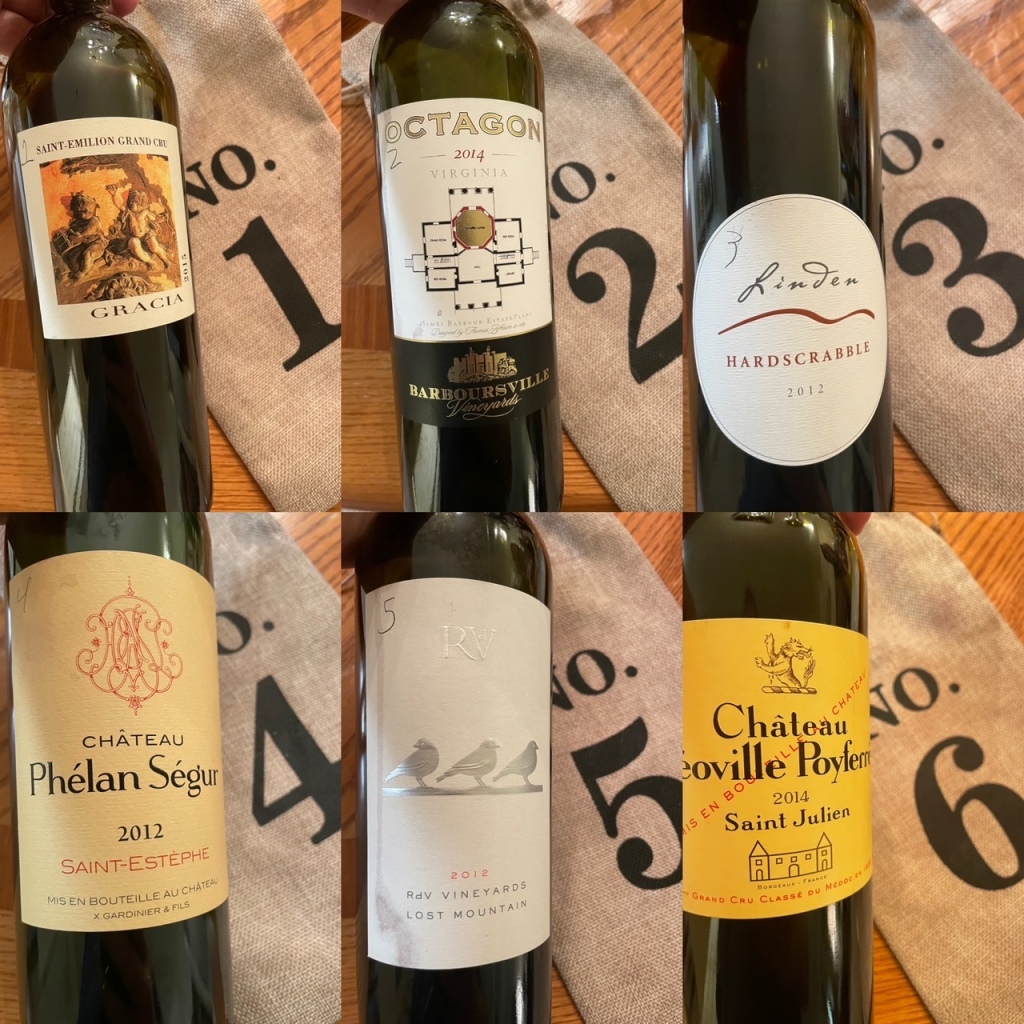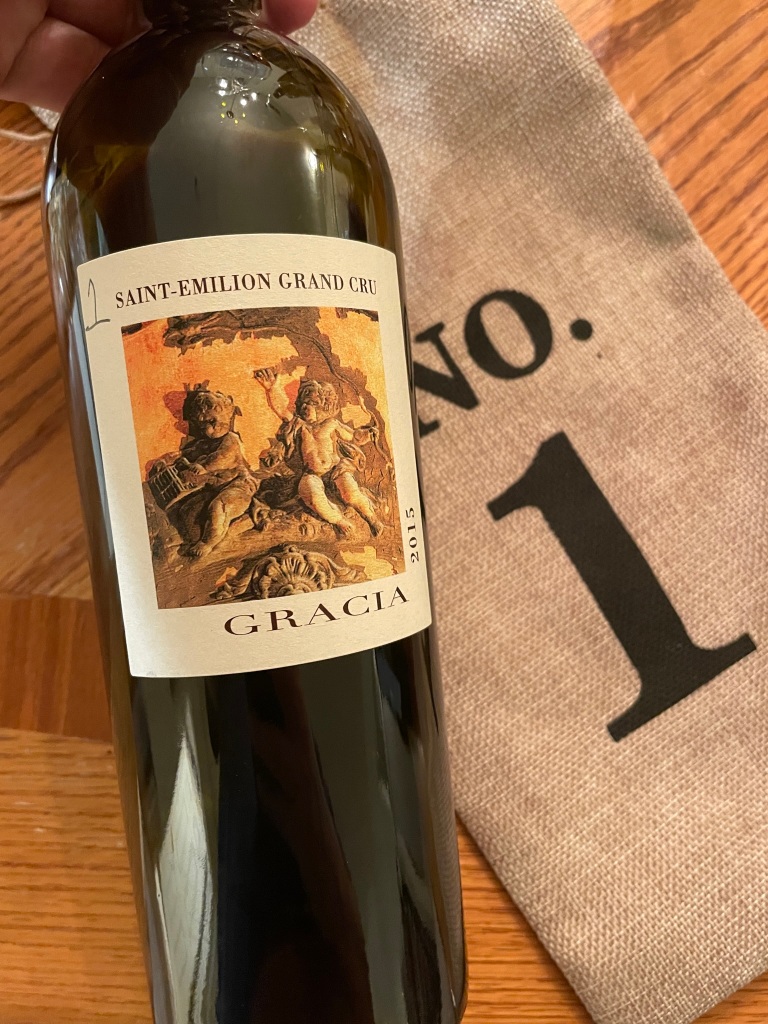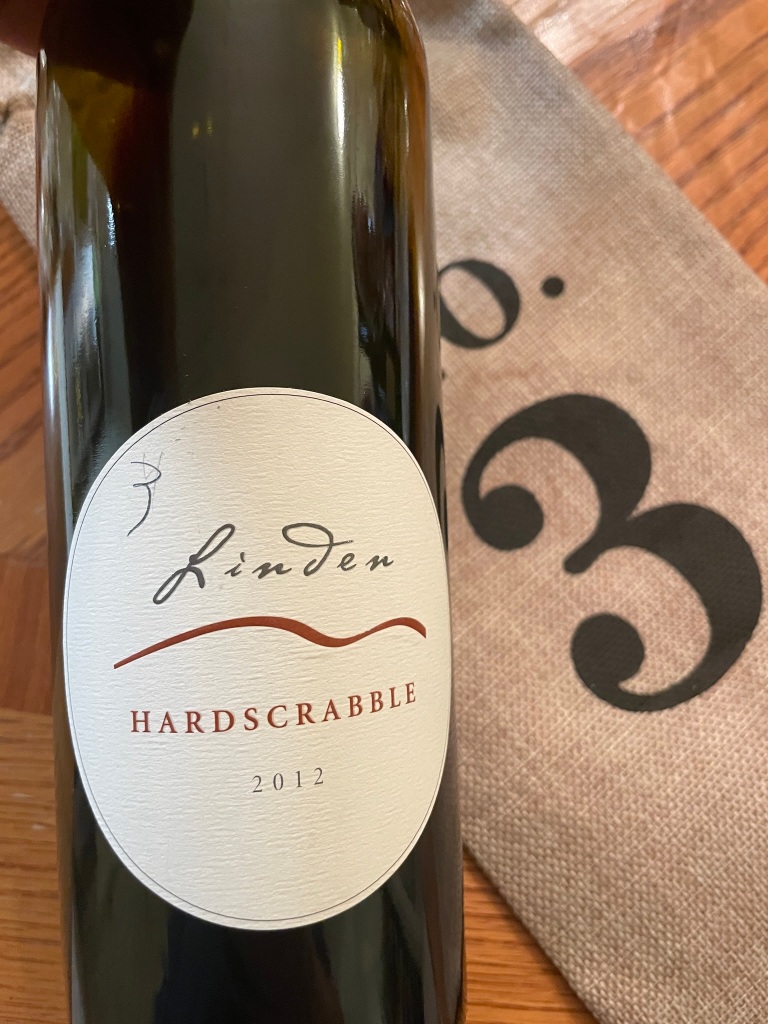A few months ago, I did a blind “Judgement of Virginia” tasting, modeled off the famous Judgment of Paris where California triumphed over France. 7 French wines were compared to 7 similar Virginia wines, all made between 2017 and 2021.
I knew our Virginia wines would do well, but to my surprise all 7 Virginia bottles beat their French counterparts. Granted I picked high-quality Virginia wineries, but even I was shocked at the blowout.
After examining the contest I realized something; Virginia went into this comparison with an advantage since its wines can be enjoyed young, while wines from Bordeaux require time to age. So, I came up with a new idea – to compare older Virginia Bordeaux-style vintages against similar French wines in order to keep the matchup even.

I invited a panel of experts (OK – they were wino friends of mine…who happened to have a great deal of industry experience and/or above average palates) and we sampled 3 Virginia Bordeaux-style wines vs 3 actual Bordeaux wines, all made between 2012-2015. Everything was done blind.
While I call this a “Bordeaux blend comparison”, that term isn’t entirely fair despite the Virginia wines using 100% Bordeaux grapes.
Cabernet Franc and Petit Verdot often play prominent roles in Virginia, but very secondary ones in France. Also, Bordeaux wines tend to favor either Cabernet Sauvignon or Merlot (often around 75% Merlot for right bank Bordeaux, but far more variable blends for left bank Bordeaux), while Virginia red blends tend to be more evenly distributed between multiple grapes. This means while the grapes may be the same, the composition of the blends could be very different.
The tasting was simple; compare two wines side by side and we’d select a favorite. While several attendees were wine judges, I elected to keep things simple and have everyone simply pick a single favorite of every flight. In the case of a tie, the host (me) decided between the two.
I bagged everything in pairs, so nobody (including myself) knew which pairs we were trying. All we knew is one wine was Virginia, and the other was Bordeaux. The specific pairings were selected in advance, based on the wine’s age and blend.
The wines:
France:
- 2012 Château Phélan Ségur: 50% Cabernet Sauvignon/ 50% Merlot (Left Bank, Saint-Estèphe) (wine searcher retail $62, with significant regional variation)
- 2014 Château Léoville-Poyferré: 60% Cabernet Sauvignon / 35% Merlot / 3% Cabernet Franc (Left bank Second Growth, Saint-Julien) (wine searcher retail $118, locally priced at $80)
- 2015 Château Gracia: 70% Merlot / 25% Cabernet Franc / 5% Cabernet Sauvignon (Right bank Grand Cru, Saint-Émilion) (wine searcher retail $111)
Virginia:
- 2012 Linden Hardscrabble: 56% Cabernet Sauvignon / 34% Merlot/ 9% Cabernet Franc / 1% Petit Verdot (selling at $75 in the winery)
- 2012 RdV Lost Mountain: 46% Cabernet Sauvignon / 40% Cabernet Franc / 14% Merlot (impossible to price due to scarcity; originally around $120 but recent vintages price at $220)
- 2014 Barboursville Octagon: 56% Merlot/ 23% Petit Verdot / 15% Cabernet Franc / 6% Cabernet Sauvignon (impossible to price to do scarcity; originally around $50 at the winery several years ago but likely retailing over $100 now).


Each of these came from well-regarded producers on both sides of the Atlantic. Even the experienced group tasting with me sometimes had difficulty identifying which was Bordeaux and which was Virginia. Of the 6 of us tasting 6 wines, I think we were accurate under 70% of the time.
As always, a caveat: this competition was the result of this day, with this group of people. It by no means indicates the wines that were selected as round favorites were superior to the other, or the wines that didn’t win their round weren’t loved. For this particular event, I’m convinced that at least 5 of the 6 wines we tried could have been selected as the ‘winner’ with a different food pairing; they were that good.
Pairing #1:
Wine #1 (2015 Château Gracia): 70% Merlot / 25% Cabernet Franc / 5% Cabernet Sauvignon (Saint-Émilion): 3 Votes
Wine #2 (2014 Barboursville Octagon): 56% Merlot/ 23% Petit Verdot / 15% Cabernet Franc / 6% Cabernet Sauvignon: 3 Votes (3 votes, round winner)


This round was evenly matched. I asked Dave McIntyre to pick a favorite and he didn’t want to give an answer; both of these were so equally well loved.
That feeling was shared amongst the group. To nobody’s surprise we were tied 3/3 (note to self – I need to have an odd number of tasters in the future). Not only that, but I think half of us (including me) got the Virginia wine wrong.
Ultimately I picked #2 to go to the next round, although it could have gone either way.
Alex: #2. Thought #1 was Bordeaux, also mentioned it was approachable. Notes of black current, red cherry, and tobacco backed by a long finish. Yet #2 was even more approachable with lots of red fruit, cola and a nice brightness to it.
Dave: #2. Loved both; didn’t want to pick between the two. #1 had a more ‘candied’ fruitiness he thought was associated with Virginia, but had less oak integration and was less harmonious because it didn’t have a lot of tannin. #2 loved it, and made a note about the color.
Matt: #1. #1 had some primary fruit on the nose but it was fading. #2 had some funk; earthy nose.
Katie: #2. She thought #1 was Virginia; liked the wine although she didn’t think the tannins were well integrated.
Kathy: #1. #1 had grippy tannins and more prominent fruit. #2 she found the fruit harder to find, and maybe a little reductive.
Vanessa: #1. Good maturity; tannins were chalky. Lots of fullness on the finish. #2 was brighter, velvety tannins, good acidity.
Pairing #2:
Wine #3 (2012 Linden Hardscrabble): 56% Cab Sauv / 34% Merlot/ 9% Cab Franc / 1% PV ( 3 votes)
Wine #4 (2012 Château Phélan Ségur): 50% Cab Sauv/ 50% Merlot (Saint-Estèphe) (3 votes, round winner)


This was another even round. I favored #4 but not by a huge degree. Again, I was wrong on which was Virginia vs France since I thought I felt a lot more Cab Franc on #4, but was proven wrong (it had none).
With another 3/3 vote I was the tie-breaker here since I favored #4, so it went to the next round. Coincidentally it was my favorite of the night.
Alex: #3: Notes of smoke, tobacco, black cherry, vanilla, blackberry, and strawberries, with a long finish.
Dave: #4. Thought #3 was dense, dark fruit note, needed more time to develop. #4 had notes of clove, and maybe a cigar box note to it. Of the two, this was the one that was presenting better ‘now’.
Matt: #4. I found #3 to be lighter on the nose; some fruit but with an earthy palate. #4 had more pepper but very smooth tannins. I admittedly thought this was Virginia.
Katie: #3. Though #3 was elegant, and ‘couldn’t stop going back to it’. Also very floral. #4 had a herbatiousness to it, and thought it needed food.
Kathy: #3. Very “pretty” wine. Stewed strawberries but not overly jammy. #4 was had a meaty and spicy note.
Vanessa: #4. Thought #3 was lighter, good fruit quality, and less extraction. Overall it was ‘elegant’. #4 had more extraction and richness. She thought it had a brett note which gave it more complexity.
Pairing #3
Wine #5 (2012 RdV Lost Mountain): 46% Cab Sauv / 40% Cab Franc / 14% Merlot (5 Votes, round winner)
Wine #6 (2014 Château Léoville-Poyferré): 60% Cab Sauv / 35% Merlot / 3% Cab Franc (Saint-Julien) (1 Vote)


This round had a clear winner. #6 came off as too tannic; my mouth was positively dry after tasting it. But #5 was enjoyed all-around.
Alex: Split his votes between the two. #5 was more approachable, with lots of black pepper baking spice, cloves, and plumb on the palate. #6 had notes of dark chocolate, cherry and red fruit, but had a harsh nose.
Dave: #5. Dave said #5 had a pretty nose, was floral, and tasted notes of black currant and soft tannin. #6 had an off-putting nose and a very tannic finish.
Matt: #5. I found #5 to have some fruit on the nose but not the palate. Of the two, this was definitely the more drinkable right now. #6 was more of a food wine. Tannic finish, very dark and brooding overall.
Katie: #5.
Kathy: #5 had notes of blackberry, plumb, maybe menthol. Wished the finish lasted longer. #6 had an interesting notes, burnt toffee character to it on the palate.
Vanessa: #5. Thought #5 was well put together, while #6 was disjointed.
Finalist Round:
Wine #2 (2014 Barboursville Octagon): 56% Merlot/ 23% Petit Verdot / 15% Cabernet Franc / 6% Cabernet Sauvignon
Wine #4 (2012 Château Phélan Ségur): 50% Cabernet Sauvignon/ 50% Merlot (Saint-Estèphe)
Wine #5 (2012 RdV Lost Mountain): 46% Cabernet Sauvignon / 40% Cabernet Franc / 14% Merlot



From most favorite to least favorite, the results were:
Alex: Wines 2/5/4
Dave: Wines 4/5/2
Matt: Wines 4/2/5
Katie: Wines 5/4/2
Kathy: Wines 5/4/2
Vanessa: Wines 4/2/5
The lowest vote earned 1 point. The runner-up had 2 points, and the favorite wine got 3 points.
2014 Octagon from Barboursville had 7 points
2012 Lost Mountain from RdV had 11 points:
2012 Château Phélan Ségur had 12 points (Finalist)

Results:
I’d say there were a few take-aways.
The biggest is I felt this event demonstrated Virginia has the ability to go toe-to-toe with Bordeaux. Of 3 pairings, Virginia tied its Bordeaux counterpart twice and once easily surpassed it. 2 Virginia wines made it to the FInalist round, and the 2012 RdV Lost Mountain was also the 2nd favorite wine of the evening.
I was pleased to see how incredibly close these parings were at multiple levels. Every wine deserved high scores, and I truly believe that on another day, most of them could have been picked as our finalist. Even identifying the Bordeaux of the mix was sometimes difficult.
Second would be that while price and quality often go hand-in-hand, that’s not 100% true. The favorite of the day was the least expensive wine of all (still not cheap at $60-ish, but still). Not surprisingly RdV came in second, but the ‘brown bag’ method definitely evens the playing field.
Lastly, if there’s a downside to this event is while this tasting showed to me Virginia’s potential, the reality is it’s nearly impossible for our average wine lover to enjoy this kind of comparison. Virginia wines are often sold young, and limited inventory means most ‘older’ vintages are almost impossible to find. Even long-time Virginia wine collectors might only have a few special bottles from the 2012 vintage (or earlier).
Also keep in mind that the Virginia wines I selected represent the ‘elite’ of what the state has to offer. Few Virginia wines can age for 10 years like these did, or are made with the exquisite craftmanship we found.
Next up – a comparison of mid-priced Virginia red blends, a Cabernet Franc day, another sparkling round, and Petit Manseng.
